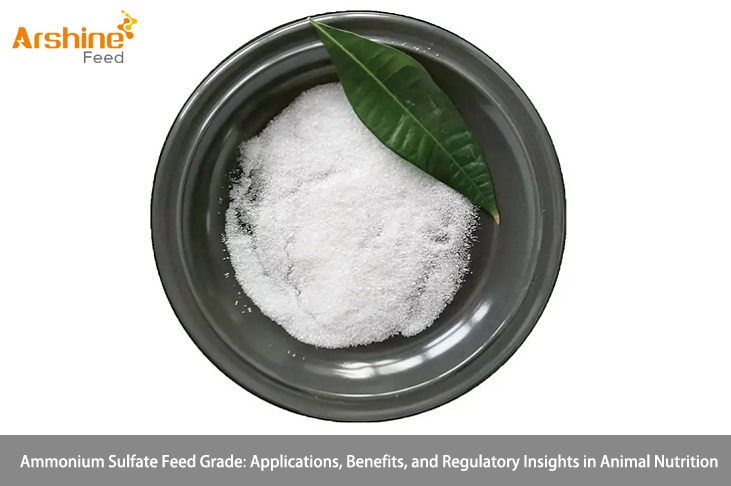

Introduction: Ammonium sulfate feed grade, a versatile nitrogen-based fertilizer and feed additive, has gained prominence in the agricultural and animal feed industries for its multifunctional benefits in promoting animal health, enhancing feed efficiency, and supporting sustainable livestock production. This comprehensive article explores the applications, advantages, and regulatory considerations of ammonium sulfate feed grade, shedding light on its pivotal role in modern animal nutrition and feed management practices.
Understanding Ammonium Sulfate Feed Grade: Ammonium sulfate (NH4)2SO4 is an inorganic salt composed of ammonium and sulfate ions, commonly produced through the reaction of ammonia and sulfuric acid. In its feed-grade form, ammonium sulfate undergoes rigorous purification and quality control measures to ensure safety, efficacy, and compliance with regulatory standards for use in animal feed and feed additives.
Applications in Animal Nutrition: Ammonium sulfate feed grade serves multiple functions in animal nutrition and livestock production, contributing to protein synthesis, nitrogen metabolism, rumen function, and overall performance optimization in various animal species. Some key applications include:
Nitrogen Source and Protein Enhancer: Ammonium sulfate serves as a concentrated source of nitrogen and sulfur, essential nutrients required for protein synthesis, amino acid metabolism, and overall growth and development in livestock and poultry. By providing supplemental nitrogen and sulfur, ammonium sulfate enhances the nutritional value of feed formulations, supports muscle growth, and improves protein quality in animal products such as meat, milk, and eggs.
Rumen Function and Microbial Activity: In ruminant animals, ammonium sulfate plays a crucial role in supporting rumen function, microbial activity, and fiber digestion. It serves as a readily available source of ammonia for rumen microbes, promoting microbial growth, fermentation efficiency, and volatile fatty acid production. By optimizing rumen pH, microbial balance, and nutrient utilization, ammonium sulfate contributes to enhanced feed efficiency, improved digestibility, and increased milk production in dairy cows and beef cattle.
Acid-Base Balance and Electrolyte Regulation: Ammonium sulfate helps maintain acid-base balance, electrolyte equilibrium, and osmotic pressure in the body fluids of animals, including poultry, swine, and ruminants. It serves as an effective buffering agent, supporting metabolic processes, cellular function, and overall physiological stability under varying environmental conditions and stressors. By regulating acid-base homeostasis, ammonium sulfate enhances animal resilience, adaptability, and performance in challenging production environments.
Ammonia Detoxification and Waste Management: Ammonium sulfate aids in ammonia detoxification, waste management, and environmental sustainability in intensive livestock production systems. It facilitates the conversion of toxic ammonia (NH3) into non-toxic ammonium ions (NH4+), reducing ammonia emissions, minimizing environmental pollution, and improving air quality in livestock facilities. By mitigating ammonia toxicity, ammonium sulfate supports animal welfare, environmental stewardship, and regulatory compliance in modern livestock operations.
Regulatory Considerations and Safety: While ammonium sulfate feed grade is generally recognized as safe (GRAS) when used in accordance with Good Manufacturing Practices (GMP) and applicable regulations, its use in animal feed and feed additives is subject to regulatory oversight by health authorities, including the U.S. Food and Drug Administration (FDA), European Food Safety Authority (EFSA), and other relevant agencies worldwide. These agencies establish maximum allowable levels, quality specifications, and permissible applications of ammonium sulfate in animal feed to ensure safety, efficacy, and compliance with industry standards.
It is essential for feed manufacturers, producers, and veterinarians to adhere to regulatory guidelines and specifications regarding the use of ammonium sulfate feed grade, including labeling requirements, maximum permitted levels, and quality control measures. Comprehensive safety assessments, efficacy studies, and quality assurance protocols should be implemented to ensure the purity, consistency, and safety of ammonium sulfate-based feed products.
Conclusion: Ammonium sulfate feed grade represents a valuable innovation in animal nutrition and feed management, offering a natural, effective, and sustainable solution for promoting animal health, enhancing feed efficiency, and supporting sustainable livestock production. Its diverse applications, proven benefits, and regulatory compliance make it an indispensable component in modern animal feed formulations and feed additive solutions.
By understanding the uses, advantages, and regulatory considerations associated with ammonium sulfate feed grade, feed industry stakeholders can leverage its potential to optimize animal health, maximize production efficiency, and meet the evolving demands of consumers for safe, nutritious, and responsibly produced animal products. As the global focus on sustainable agriculture, animal welfare, and food safety continues to grow, the strategic incorporation of ammonium sulfate feed grade into animal nutrition strategies offers promising opportunities for innovation, growth, and excellence in the dynamic landscape of animal agriculture.
Add: Block 14, No.100, Luyun Road,Changsha 410205,China.
Mobile: +86 18874001228
Email: info@arshinefeed.com
WhatsApp: 8618874001228
WeChat: weiyuyan91